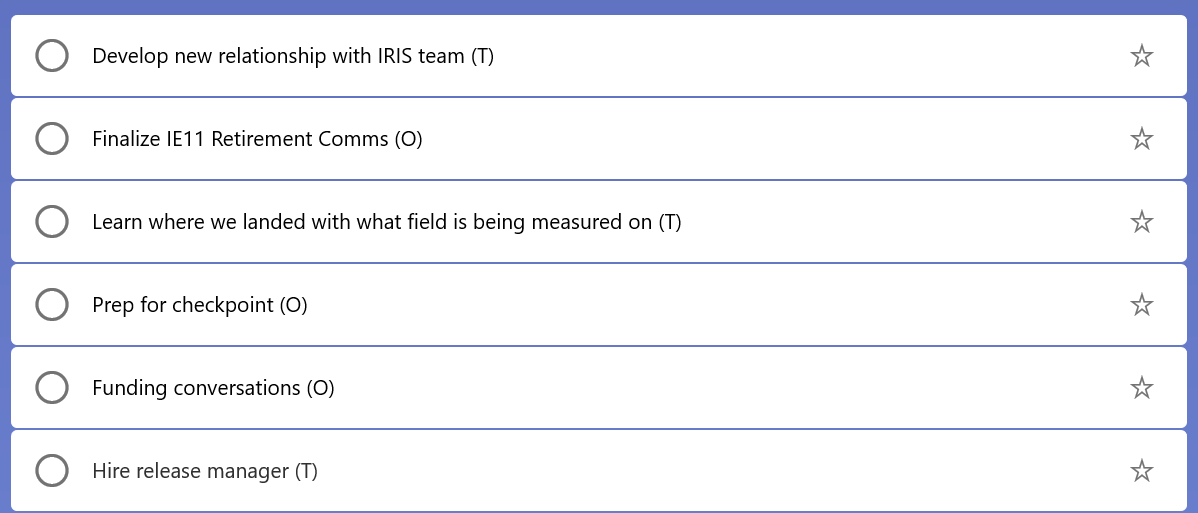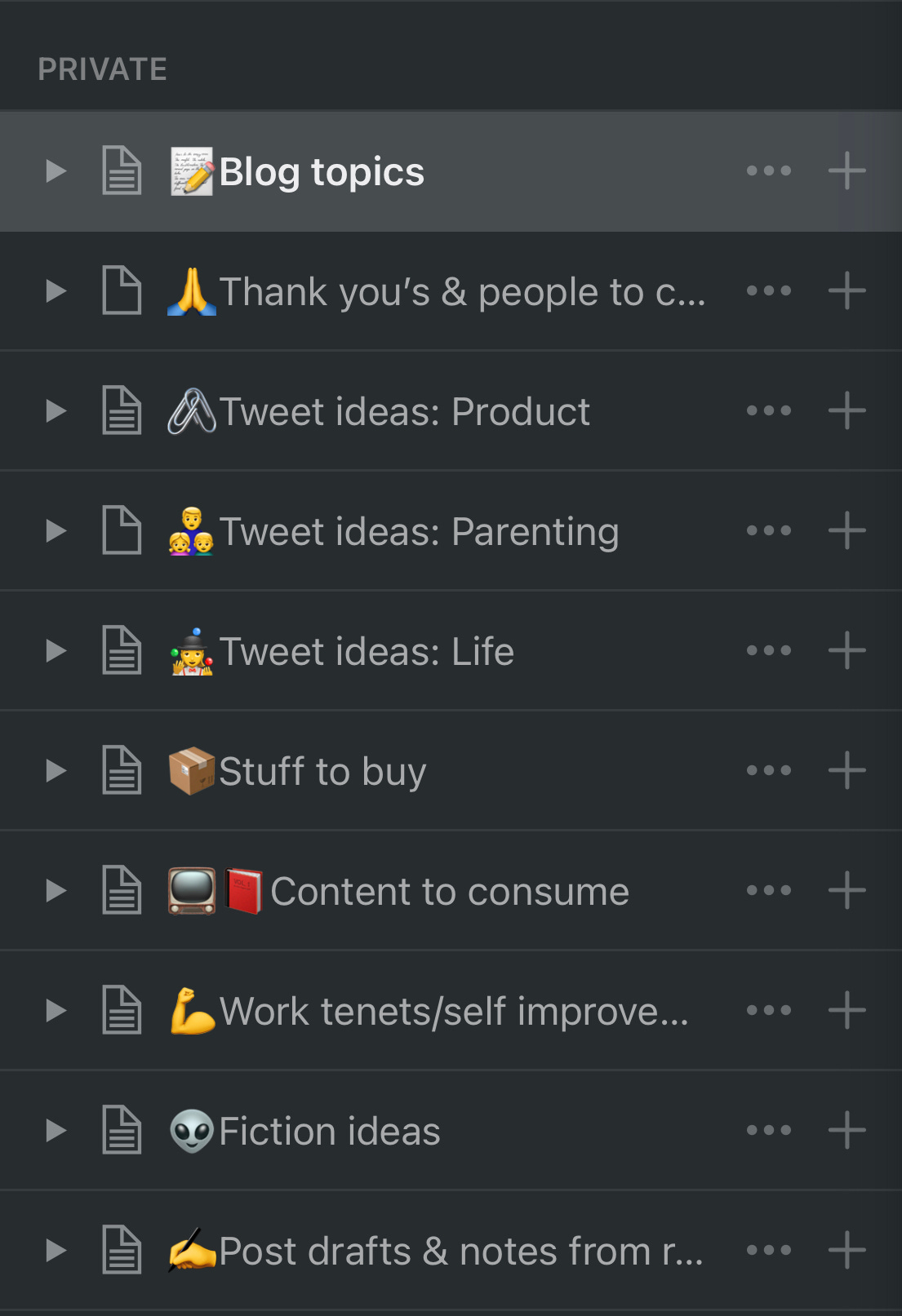How does a product leader manage their time?
My 16 year journey to grasp the calendar, task, notes, and email fundamentals of the knowledge economy
When I first graduated from college and entered the tech workforce, one of the most striking differences was just how much information there was to consume:
College classes taught me theory and how to think, but I was unprepared for the onslaught of meetings, email, chats, content to digest, and tasks to switch between. My time in college extracurriculars was better preparation than anything in the classroom, but it was still a step function change as I entered the official knowledge economy.
On the one hand, I loved it. I had an opportunity to go back to school for a PhD but decided against it because I felt most alive when building something bigger than I could ever achieve myself. “Big” was challenging. “Big” was impactful. “Big” was the thing I wanted to get great at.
But on the other hand, I had much to learn and no playbook to follow. I am an introvert, so my intuition wasn’t grounded in a natural ability to navigate a highly collaborative environment. It’s not where I drew energy from, so I had to be intentional and hustle to develop the skills needed. When I looked around at those I admired the most, it was this intense ability to process massive amounts of information collaboratively – quick to pattern match, curious to always digest more, and never seeming to be “full up” in what they needed to be informed about. I wanted to be like that!

16 years later into my career and I feel more comfortable with these basics of thriving in a large, multi-disciplinary environment that is collaborative by default.
Here’s what worked for me, which is actually a Part III in an ongoing series on how I spend and manage my time as a product director in big tech. (Links to Part I and Part II below).
(Part I) Managing Calendar: The Buckets of Work
In Part I, Where Does a Tech Product Leader Spend Their Time?, I talk about figuring out a bucketing framework for my calendar – breaking it down between strategy, product, team, and customers. I talk about how I am proactive about my meetings (2000 in a year!) to conform to my framework.
(Part II) Information Diet: What I consume
I am an information junkie and believe consuming news, analysis, podcasts, and newsletters is a way to develop intuition. I talk about my personal information diet here: My Information Diet.
I consider the Information Diet as part of my time management plan – getting into nutritious info habits is on par with establishing good calendar and task hygiene.
Now, before we get to Part III, might I suggest you subscribe to Mind The Beet to receive articles like the ones above every Sunday morning? It’s free!
And now, on to Part III:
Managing My Task List: Making Time for Epic
When I’m not at my best, I limit my task list to only being a source of stress reduction. I get a cathartic high by writing down everything that’s urgent and it’s generally done with whatever tool is closest: sticky notes or just Notepad.exe. This is valuable because it keeps me organized but it feels like the tasks are in control, not me.
When I am at my best, I practice my most important career philosophy: Make Time For Epic (MTFE). MTFE recognizing that a small subset of your tasks yields the most impact. It makes room to prioritize the important over the urgent. Here’s how I put that into practice:
I have three tasks lists:
Small work items are for things that don’t take substantive thought. When I have an hour, I probably get 5-10 small work items done. However, it’s less about time and more about the energy and unique thinking I need to put in.
Big work items are my choices for the “themes of my week.” These are items that take complex, differentiated work from me. Sometimes they are just an unsolved problem and sometimes they are a fixed activity/solution. But I always define outcomes and focus on the impact, not the activity. Examples include:
Writing a strategy whitepaper to generate durable closure on an open issue
Planning an offsite to bring my leadership team together
Giving substantial feedback on a design sprint in order to quicken development of an area
Doing customer research to clarify my own thinking
To double down on the MTFE framing, I recently started to adopt a new practice I heard about on a podcast with Shreyas Doshi and John Cutler: Labelling tasks as either Transformative (T) or Overhead (O), like this:
Transformative tasks are ones that demonstrate my unique value to the team and are often potential step functions of impact. They are almost always epic in the MTFE framing. My examples above involve developing a deeper relationship with a partner team or hiring new type of talent. We’ll have a stronger team and product tomorrow than we do today if I complete a transformative task. They can be built off of.
Overhead tasks are obligations I feel I owe to others. They could be epic – sometimes the most impactful work is running the business vs. transforming it – but often they are more the stuff I “have to do.” Often I’m not building off the success of overhead tasks. My personality type feels deeply attached to what others expect of me, so I treat overhead with more care than most that I know.
Every Week is a New Campaign
When I’m at my best, I’m intentional about the themes I choose for my work week. My week has a recently chosen purpose with a clear set of outcomes and, as a team leader, that’s done in a transparent an open manner.
In fact, during the pandemic, I made the best change to my work style that I’ve made in the past decade. To help keep newly remote employees feeling connected, I reconfigured my Monday morning to include an 11:30AM standup with the team but completely free of meetings before then. I spend about 60 minutes of that morning compiling a left-to-right view of what’s going on around the team and company. I sent it out as an internal newsletter (now up to about 200+ people) and review it with the team in the standup.

This new process has had a number of benefits:
I consistently receive positive feedback about it being a great resource for the team, especially partners and new hires. This is validated by high open rates and forwards.
I role model the importance of clarity in written comms to the team (We are in the process of moving from a PowerPoint-centric to a written word centric culture).
It enables me to organize my own thinking and weigh in on what’s most important.
It is a forcing function for me to catch up on any in progress work or missed status.
Critically, it’s after writing this newsletter every week that I choose my “Big Things” to focus on. There is a lot of power in working openly and transparently and to take the time at the weekly cadence to ensure the highest impact outcomes are what I target.
Notetaking & Lists
I was a fan of reading U.S. Presidential biographies when I was in my early twenties. One of the things that stuck with me was that almost every successful leader was a copious notetaker. As I’ve gotten older and my time is pulled in more directions between work, families, hobbies, and community – I’ve needed more structure to write down stray ideas before they disappear or to synthesize the outcomes of work with others.
When I’m not at my best, I find my notes scattered throughout a mix of unfiled OneNotes, unsaved notepad files, and embedded into my tasks list as work items. This feels a bit like survival mode. In fact, one of the best signals to me that I need to take a step back and recenter is when I find myself doing this.
When I’m at my best, I use notetaking to improve as a team leader and person.
First, for synthesizing time with others, I try to actively volunteer to be the notetaker when I can. Using notes to uplevel, synthesize, and nudge towards durable closure is a transformative not an overhead task and one I am eager to role model for the team. I almost never keep private notes from meetings, instead preferring to work transparently and openly.
Second, the private lists I keep are an intentional statement of where I want to grow right now. I am planful of how I spend my in between moments and spare thoughts. A few months back I switched to Notion for this:
I’m working on showing more gratitude, growing as an author/writer, engaging more on social media, and prioritizing time for new things in my information diet. Having that structure and rigor pre-defined enables me to quickly seize the thoughts and ideas as they come to me. This is especially true of my writing pursuits, something I’m actively trying to incubate in my life right now.
Managing Email and Comms: OHIO Principle
I receive 7,000 work emails and participate in 4,000 work chats in a year. So no post on how I manage my time would be complete without discussing strategies for managing the inbox.
It’s overwhelming and I’ve tried a lot of tactics over the years to manage the flow from aggressive filtering to categories to creative uses of flag for follow-up. What I’ve found works best for me is rooted in three principles:
My life is less stressful when my inbox is a source of connection and not a to-do list.
If I send less email, I get less email.
I look for opportunities where others can respond instead of me.
The most durable mechanic I’ve found for putting these into practice is the OHIO principle: Only Handle It Once. OHIO is a form of Zero Inbox where the point is to not to have to process an email more than once (see principle #1 -> don’t make your inbox a todo list). When I get an email, I do one of three things:
Archive/delete it
Quickly respond/action
Create a Todo item in my task tracking app and then archive the email.
The strategy gets me out of the middle. I either quickly reply to unblock someone or I use something other than my inbox to track a thoughtful reply or read. This also helps me put principles 2 & 3 into practice as it enforces a pause. I did an experiment a couple years ago where I was intentional about not responding to mail for 2-3 days. I was surprised by both how much less mail I got myself (duh, I suppose in hindsight) but also how often someone else responded in the same way I would have, or even better. It’s been a tool I use to be intentional about empowering folks on my team as well as freeing up more of my own time.
Wrapping Up
I know I should find a way to be more humble about this, but I’ll be forthright: I think over the past 16 years I’ve developed a phenomenal ability to process large amounts of information and focus on impact and importance over urgency. It’s what I get the most compliments about at work and I take significant pride in being good at these basics. What I do here may not work for you (this isn’t a playbook and it takes practice) – but it’s a complete summary of one of my biggest successes as a professional and something I think is directly responsible for my career and work success.
In fact, when we started Mind The Beet, this ongoing series of how I spend my time across calendars, content, tasks, and comms was top of mind for me to synthesize. It feels good to be reaching Part III and concluding my reflections on what amounts to the fundamentals of being a productive knowledge worker. Please let me know anything you are curious about – I’d love to do a Part IV based upon reader feedback!
If you liked this post, here are a few others across product, parentings, career, and life:
🎁 The Gifts We Hope to Give: The one question emerging leaders should be asking
👶 Advice on Hiring a Nanny: Practical tips for working parents
🎙 The Studio: A product guide to building a custom telepresence room
🤗 A Day In the Life of a Frontline Manager: Battle tested advice for new frontline managers
🤝 Thriving In The Matrix: An Informal Conversation with 3 Microsoft Veterans on Cross-Team Work: A philosophy on collaboration
My wife (also a product exec but in a startup) and I take turns posting every Sunday morning. Subscribe for our slice of life! It’s free. [An Airtable of all our articles: https://mindthebeet.com/articles]
Bonus: Invite to Polywork
We’ve trying something new in the closing of this week’s newsletter: a mention of a new app. Polywork is a new professional social network designed for the modern era and it just closed a funding round (see here) I set up my own Polywork page: https://updates.mindthebeet.com. It’s a running list of my projects and accomplishments organized by tags and badges – all public. There is a real nugget of insight it’s capturing that LinkedIn is failing to do: our lives are more complex than job titles and positions and many of us have side gigs. A focus on projects, accomplishments, and content feels more appropriate for a future of work that is often ad hoc collectives of people jamming together. The product itself is rough and early – with a fair number of bugs and no mobile app yet - but I like the way it’s pushing on the definition of an online home for my work. Anyway, it’s invite online right now but you can use this invite code to join: aharmetz-rapidash at https://polywork.com. Let me know what you think if you try it out and I’ll be the first to ask you: Follow me on Polywork!









That's a very important topic! I already wrote twice about it:
1. Principles for prioritizing competing work: https://www.leadinginproduct.com/p/principles-for-prioritizing-competing
2. How to manage tasks as a product manager: https://www.leadinginproduct.com/p/how-to-manage-tasks-as-a-product
Thank Adam for your contribution!
Adam,
This post feels so relevant to my work situation, I had to read every word. It might be the first post on your blog I've read from end to end. There's a good mix of storytelling and digital work-related tips. The urgent vs important graphic pulled me in. It looks original though it's based on a meme.
This quote hooked me:
"I did an experiment a couple years ago where I was intentional about not responding to mail for 2-3 days. I was surprised by both how much less mail I got myself (duh, I suppose in hindsight) but also how often someone else responded in the same way I would have, or even better."
I'm curious how you only touch email once when you don't respond for 3 days. I'm trying to imagine figuring out how to only read 3 day old emails when so many threads go on for days.
-Tom